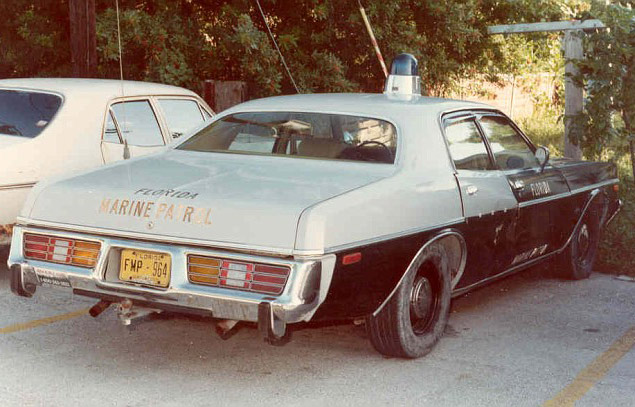Florida Highway Patrol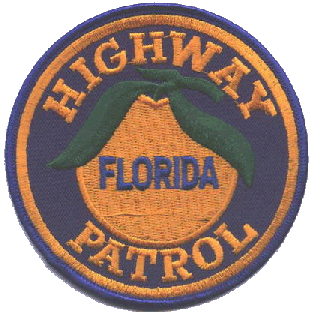
Florida Highway Patrol
On November 23, 1931, under the administration of Governor Doyle E. Carlton, at the request of the Chairman of the State Road Department, Attorney General Cary D. Landis ruled it shall be the duty of the State Road Department to maintain the state roads and enforce the laws enacted to preserve its physical structure. As a result of this ruling, the road department hired 12 weight inspectors who were placed under the supervision of the division engineers.
This was the beginning of state law enforcement in Florida. Uniformed Officers of the SRD drove patrol vehicles with SRD coded license plates from 1931 to 1939.
In 1939, the Florida Legislature created the State Department of Public Safety with two divisions; the Florida Highway Patrol and the Division of State Motor Vehicle Drivers Licenses. The legislation authorized 60 officers to patrol the public highways and to enforce all State laws in effect, or hereinafter enacted, regulating and governing traffic, travel and public safety upon the public highways, and providing penalties for violations thereof, including the operation, regulation and licensing of motor vehicles and drivers thereof, and other vehicles thereon, with full police power to bear arms and to arrest persons violating said laws.
In 1947, the first FHP Patrol station was built in Tallahassee. At the close of 1950, the FHP had 171 Patrolmen on the road. The 1951 Legislature authorized a pay increase to $275 per month and increased the authorized strength to 300 patrolmen; however, the lack of funds kept the Department from employing them.
In late 1952, the Patrol realigned the divisions. Boundaries were changed and divisions became Troops and were designated as A, B, C, D, E and Headquarters Troop.
By 1960, Troop E, headquartered in Miami, had grown so much it was necessary to take Palm Beach, Martin, St. Lucie, Indian River, and Okeechobee Counties and form Troop L headquartered in West Palm Beach. Broward County was added to Troop L in 1981. At the end of 1963, the Patrol had 566 officers.
In 1964, the wording 'State Trooper' began to show up on all Florida Highway Patrol cars on the doors and trunk. The word 'State' appeared above the seal and the word 'Trooper' appeared below the seal. Sergeant Tom Joyce, Public Information Officer, brought this information and samples back from the State of Tennessee after a meeting.
In 1983, the Patrol purchased its first Mustang Patrol Cars. The Mustang's handling was one of its greatest assets. Patrol cars of the past were as fast but did not have the high speed handling capabilities of the Mustang. The vehicle responded well to high speed and low speed curves.
Motorcycles were once a staple of the Highway Patrol enforcement program and became extinct for a period of time. They are now back and hopefully, here to stay. The Patrol's new motorcycle section was re-instituted in Miami for traffic enforcement in the latter part of 1985. Their return was brought about largely due to an outbreak of highway robberies occurring on I-95 in Dade County.
The Florida Highway Patrol took delivery of 200 new Chevrolet Camaro patrol cars in 2002. In addition to the installation of the radio system and new low profile Whelen light bars, each trooper issued the high performance patrol car had to complete a five-hour familiarization class on the handling, braking and acceleration of the 310 horsepower vehicle.


 1936- White over red.
1936- White over red. 1937 issue- Embossed steel.
1937 issue- Embossed steel. 
It is believed by most, that FHP-prefixed license plates were issued to FHP patrol vehicles beginning in 1940. It is also believed based on the few surviving specimens and old photos, that the FHP plates in the early years used the opposite color scheme of regular passenger plates of the day. The plates were still approximately 5 1/4" x 12" embossed steel and issued in pairs. There is also the belief that a double-colored background plate was used by the FHP in 1941 with dark blue on the left half and red on the right half and using white embossed characters. There is no known surviving physical specimen to support this belief, but the 1941 photo seen below lends itself to interpretation as it offers no clear and confirming detail being a black and white photo.
 1940 issue- Embossed steel.
1940 issue- Embossed steel. 

 1941 issue- Embossed steel. Approx. 5 1/4" x 12" Likely white over red as it would be the reverse color scheme from all other issues in the state that year. FHP-### over 19 FLORIDA 41
1941 issue- Embossed steel. Approx. 5 1/4" x 12" Likely white over red as it would be the reverse color scheme from all other issues in the state that year. FHP-### over 19 FLORIDA 41  1941 issue. White over red. FHP-### over 19 FLORIDA 41.
1941 issue. White over red. FHP-### over 19 FLORIDA 41. 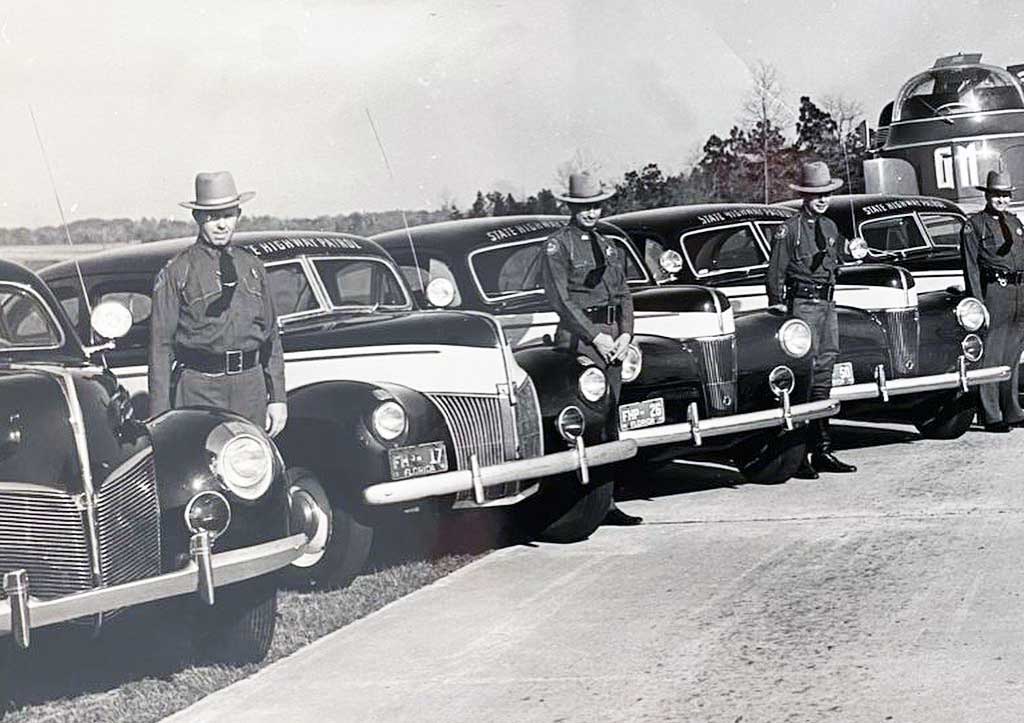 1941
1941
 1942/43 issue- Embossed steel.
1942/43 issue- Embossed steel. 
 1942/43 issue. Blue over orange. 19 FLORIDA 42 over FHP-###. Valid also throughout 1943.
1942/43 issue. Blue over orange. 19 FLORIDA 42 over FHP-###. Valid also throughout 1943. 1944
1944 1944 issue- Embossed steel.
1944 issue- Embossed steel. 
 1945 issue. Yellow over black. FHP-## over 19 FLORIDA 45.
1945 issue. Yellow over black. FHP-## over 19 FLORIDA 45.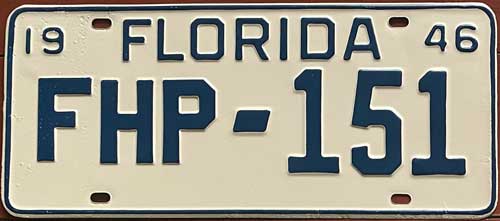 1946 issue- Embossed steel.
1946 issue- Embossed steel. 1946 FHP-115
1946 FHP-115 1947 issue. Green over white. FHP-### over 19 FLORIDA 47.
1947 issue. Green over white. FHP-### over 19 FLORIDA 47.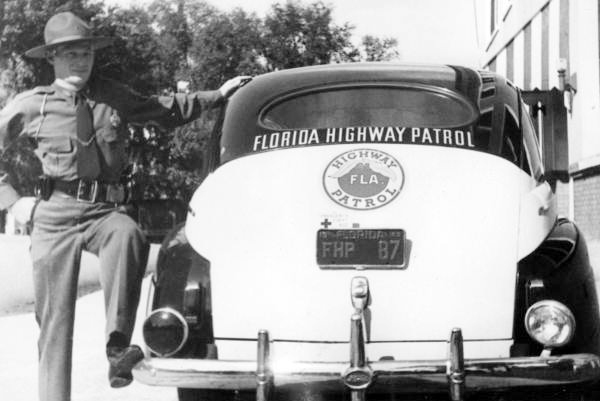

 1948 issue on a brand new '49 Ford. Black over yellow. 19 FLORIDA 48 over FHP-### (Courtesy Jeff Peeler)
1948 issue on a brand new '49 Ford. Black over yellow. 19 FLORIDA 48 over FHP-### (Courtesy Jeff Peeler) 1950 issue. Orange over dark blue. 19 FLORIDA 50 at top. FHP-## over SUNSHINE STATE at bottom.
1950 issue. Orange over dark blue. 19 FLORIDA 50 at top. FHP-## over SUNSHINE STATE at bottom. 1951 issue. Yellow over dark green. KEEP FLORIDA GREEN over FHP-## over 19 FLORIDA 51
1951 issue. Yellow over dark green. KEEP FLORIDA GREEN over FHP-## over 19 FLORIDA 51 1954-1955 issue- Embossed steel. Approx. 5 1/4" x 12"
1954-1955 issue- Embossed steel. Approx. 5 1/4" x 12" 

 1955 issue. Embossed steel.
1955 issue. Embossed steel.
 1956-1960 issue- Embossed steel.
1956-1960 issue- Embossed steel. 
 1954 issue with 1961 validation decal applied over the 54.
1954 issue with 1961 validation decal applied over the 54.
1960 was the year when permanent license plates began to be used by the FHP for all of its marked patrol vehicles. The plates were supplied by the 3M Company of Minnesota,
which is a practice that still intermittently continues to this day. In fact, the older Type 1 and Type 2 versions of these plates featured the very distinctive choppy mitered die fonts that Minnesota license plates used from the late 1920's until 1954.
FHP license plates from 1960 onward vary in
material and composition, sometimes very slightly, so I will attempt to do my best to accurately describe the
variations as they are known to me and approximately when they were issued. As with everything on this website, I rely heavily on the observations of others
who may have a better recollection or knowledge of what they have seen or have, so if there are any errors, please
advise me.
 1960-Circa 1965 issue- Known as Type 1. Embossed galvanized steel. Blue over reflective white.
1960-Circa 1965 issue- Known as Type 1. Embossed galvanized steel. Blue over reflective white.

 Circa 1960. Showing Type 1 plate with 19 and decal for year in bottom corners of the plate.
Circa 1960. Showing Type 1 plate with 19 and decal for year in bottom corners of the plate. 1960
1960 

Type 2 FHP plates were same in format, color, and dies as Type 1, however made of aluminum and shellacked on both sides. All subsequent issues for the FHP are made of aluminum. Only a couple of these types remain in captivity, and it is believed that Type 2 plates were not part of a wide-range change-over but made in continuance of the Type 1 issue with the cheaper material.


 (Courtesy Jeff Peeler)
(Courtesy Jeff Peeler)
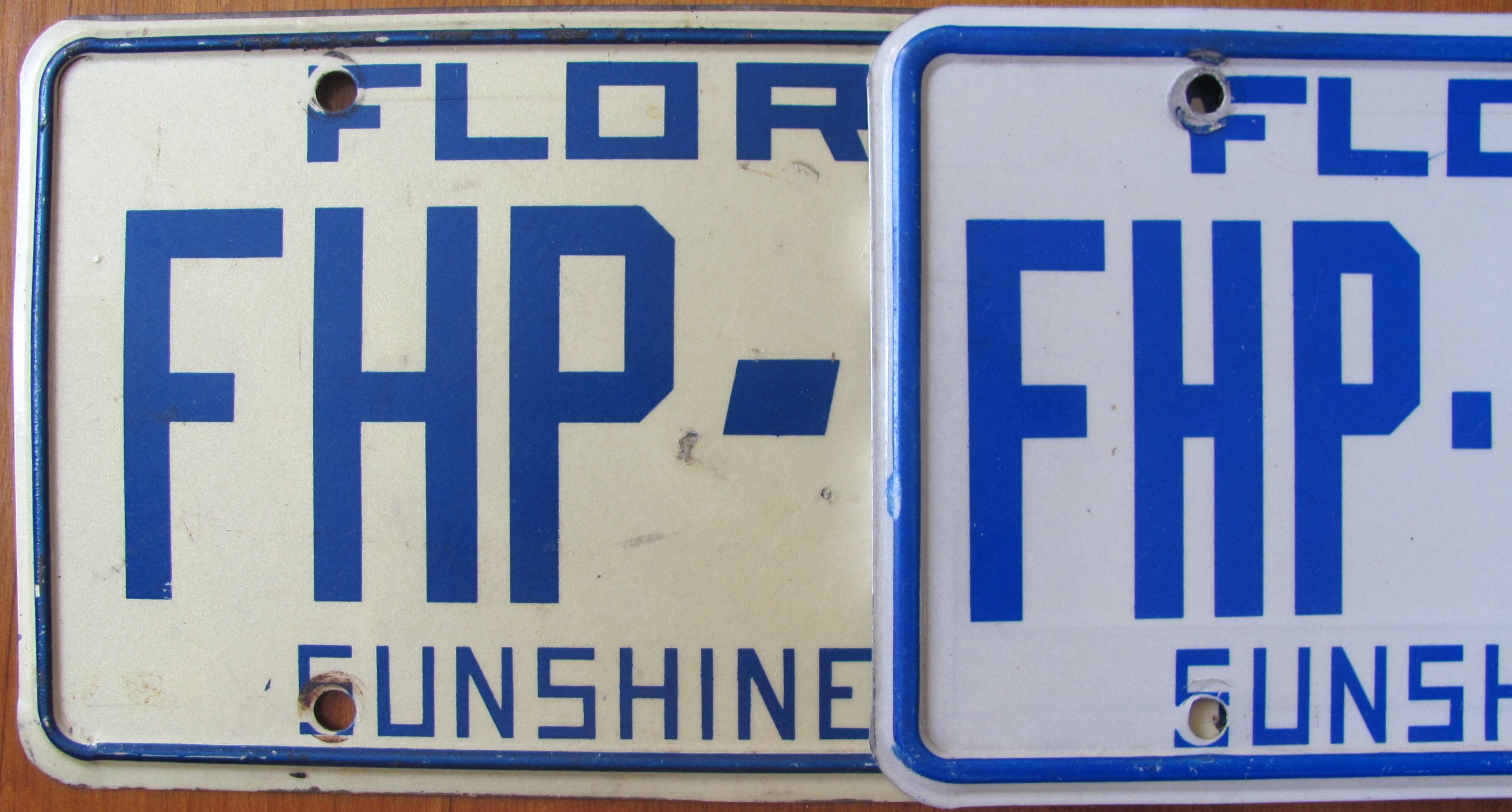
This photograph shows how to tell the difference between an early-issue FHP permanent license plate and all subsequent types. Although the screened state name and slogan remain the same, the FHP prefix and dash are the tell-tale difference.
On a Type 1 and Type 2 plate, the letter P of FHP is almost entirely under the letter O of FLORIDA. The dash is also a large parallelogram.
All later types use a thinner font for the FHP prefix where the P falls under the letter L of FLORIDA and the dash is smaller and more square.
The thinner FHP prefix and smaller dash was introduced in anticipation of FHP fleet numbers going into 4 digits and the space for the extra number was required.
 Early 1970's-1980's- Known as "Type 3"- As pictured,
similar to Types 1 and 2, however with the thinner
FHP prefix. This plate also has a small engraved
number 1 in the lower right hand corner. It is believed, that
plate 1 was issued to the vehicle, and plate 2 was a spare retained by the fleet department in the
event of loss or theft. ARRIVE ALIVE plates were used on the front during this period.
Early 1970's-1980's- Known as "Type 3"- As pictured,
similar to Types 1 and 2, however with the thinner
FHP prefix. This plate also has a small engraved
number 1 in the lower right hand corner. It is believed, that
plate 1 was issued to the vehicle, and plate 2 was a spare retained by the fleet department in the
event of loss or theft. ARRIVE ALIVE plates were used on the front during this period. 1977 FHP Plymouth Fury with Type 3 plate
1977 FHP Plymouth Fury with Type 3 plate
 Circa 1980-1987- Known as "Type 4"- As pictured, similar to its predecessor but the only difference being the use of a smaller and softer-looking die for the numbers compared to the previous choppy mitered-style Minnesota dies.
Circa 1980-1987- Known as "Type 4"- As pictured, similar to its predecessor but the only difference being the use of a smaller and softer-looking die for the numbers compared to the previous choppy mitered-style Minnesota dies.  Courtesy Chris Kiger
Courtesy Chris Kiger (Courtesy Jeff Peeler)
(Courtesy Jeff Peeler) Circa 1987- Known as "Type 5"- As pictured, similar to its
predecessor but with the only difference being the elimination
of the painted embossed border in favor of a step border and a
more defined die as can be seen on the serif of the number 1
compared to that seen on Type 4.
Circa 1987- Known as "Type 5"- As pictured, similar to its
predecessor but with the only difference being the elimination
of the painted embossed border in favor of a step border and a
more defined die as can be seen on the serif of the number 1
compared to that seen on Type 4.

From 1987 until 2003, the FHP began issuing "Troop Plates". The plates featured the added distinction of displaying the Troop letter where the plate number was assigned. These license plates varied in so many ways as the plates were primarily manufactured and donated by 3M as a means to test the durability of their plates in the Florida climate. The plates follow the same format with the state name positioned between the upper mounting holes silkscreened blue in upper case font. The word TROOP was silkscreened in blue with smaller upper case font on the bottom of the plate which was positioned off-center between the lower mounting holes. The space to the right of TROOP was to accommodate a reflective white decal with the assigned troop letter in blue. The FHP prefix was followed by one to four assignment numbers. These elements are the only consistent application on these plates. Character die types, sheeting, gauge of aluminum, holograms and paints are a hodge-podge over the course of 15 years and it is difficult to tell which came before the other.
Dated holograms in the reflective sheeting have only been detected on a couple of examples. Again, I will do my best with the chronology here by placing them in the order based on the date of those holograms where the month/year appears. Otherwise, I must rely on period photos and input of those individuals who can attest as to "which came when".

 1987-2003 issue. Earliest type. January 1987 hologram in the background sheeting. Embossed Alaska-style dies on the plate situated very low. Troop B (Lake City)
1987-2003 issue. Earliest type. January 1987 hologram in the background sheeting. Embossed Alaska-style dies on the plate situated very low. Troop B (Lake City)  1980's Ford LTD with early issue Troop plate.
1980's Ford LTD with early issue Troop plate. 1987-2003 issue. Embossed Alaska-style dies more centered.
1987-2003 issue. Embossed Alaska-style dies more centered. 
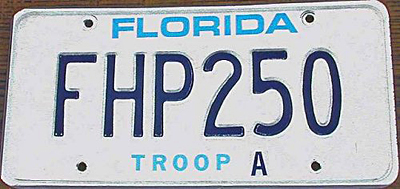 1987-2003 issue. No space between FHP prefix and numbers. Dark blue paint on characters rather than medium-blue typically used.
1987-2003 issue. No space between FHP prefix and numbers. Dark blue paint on characters rather than medium-blue typically used.
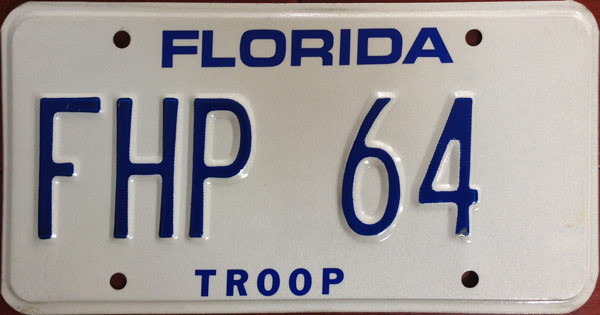 1987-2003 issue. This one using the embossed Irwin-Hodson of Oregon dies, has the 1990 hologram running down the center of the reflective sheeting as seen at right.
1987-2003 issue. This one using the embossed Irwin-Hodson of Oregon dies, has the 1990 hologram running down the center of the reflective sheeting as seen at right. 1990 holograms.
1990 holograms.From November 15th 1989 to December 31 1989, the Florida Highway Patrol introduced very attractive graphic license plates commemorating the 50th Anniversary of the FHP. The plates were embossed aluminum with a reflective white background. Across the span of the plate just below the upper mounting holes was the title FLORIDA HIGHWAY PATROL silkscreened in blue. An assignment number up to four digits was embossed in green to the center right of the plate. On the left side of the plate was a silkscreened graphic in orange, dark blue, aquamarine and green. The emblem of the FHP was superimposed over a motif of the state which is topped with a scroll that reads: COURTESY-SERVICE-PROTECTION. The FHP emblem is flanked on the left by a crop of palm trees and foliage, with a scroll below it that reads: 1939-1989- 50 YEARS.
The plates were stated by some to have been run "rear only" on marked FHP vehicles and others state they recall being run on the front. Some say the assignment numbers were issued based on seniority, others say they were radio call numbers. Many also state they were just issued randomly. What IS the biggest oddity in all of this, is that not only is there a strange lack of confirmed information about these plates, but in all of the years I have been collecting and documenting state police and highway patrol license plates, I have NEVER come across a period photo of one of these plates actually in use!
I know they were, but I would just LOVE to see what one looked like "in action back in the day".
Once the Anniversary was over, these plates were for the most part retained by the assigned FHP officer and kept as souvenirs.
 1989 50th Anniversary issue. Used only for a month and a half (November 15th-December 31 1989) on FHP marked vehicles to commemorate the Golden Anniversary of the FHP.
1989 50th Anniversary issue. Used only for a month and a half (November 15th-December 31 1989) on FHP marked vehicles to commemorate the Golden Anniversary of the FHP.
 (Courtesy Tom Seymour)
(Courtesy Tom Seymour) FHP 50th Anniversary issue "stock" plate. Unknown as to the actual usage, but there has been speculation that these could have been used on pool vehicles not assigned to a particular badge or radio number.
(Looking for confirmation/clarification on this)
What I do know is that they seem to be a bit more
rare to find than the numbered plates.
FHP 50th Anniversary issue "stock" plate. Unknown as to the actual usage, but there has been speculation that these could have been used on pool vehicles not assigned to a particular badge or radio number.
(Looking for confirmation/clarification on this)
What I do know is that they seem to be a bit more
rare to find than the numbered plates. 
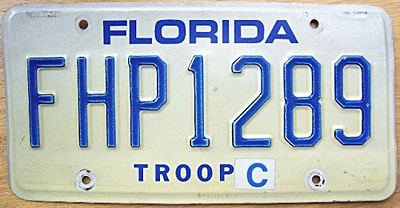 1987-2003 issue. Features narrow mitered dies used by Florida DMV not 3M.
1987-2003 issue. Features narrow mitered dies used by Florida DMV not 3M. SSP Mustang with narrow mitered die version plate
SSP Mustang with narrow mitered die version plate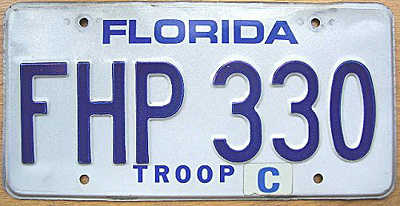 1987-2003 issue. Large and deeply embossed characters in dark blue.
1987-2003 issue. Large and deeply embossed characters in dark blue.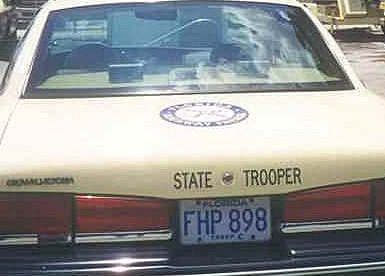
 1987-2003 issue. Unusual all-screened version where state name appears to be in different font from typical layout.
1987-2003 issue. Unusual all-screened version where state name appears to be in different font from typical layout.
 1987-2003 issue. All-silkscreened. Began to be issued circa 1999.
1987-2003 issue. All-silkscreened. Began to be issued circa 1999.
 1987-2003 issue. All-silkscreened 4-numbered version. Features holograms depicting this plate as manufactured in 1999.
1987-2003 issue. All-silkscreened 4-numbered version. Features holograms depicting this plate as manufactured in 1999. 
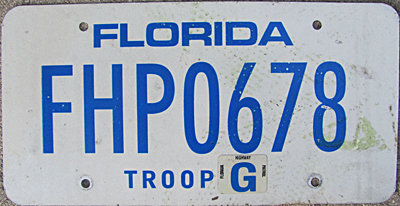 1987-2003 issue. Later version. All-silkscreened on entirely flat borderless sheet of aluminum. Uses a font style for assignment number not normally seen on FHP plates.
1987-2003 issue. Later version. All-silkscreened on entirely flat borderless sheet of aluminum. Uses a font style for assignment number not normally seen on FHP plates. 
In 2003, the Florida Highway Patrol gradually began phasing-out the "troop plates" which had been in use for over 16 years in favor of a new and attractive graphic design.
While attending a conference in Atlanta, Georgia, FHP Colonel Chris Knight had observed the attractive and distinctive graphic license plates used by the Georgia State Patrol on their vehicles. Upon his return to Tallahassee, Colonel Knight began setting in motion the necessary action to get equally attractive and equally-distinctive license plates made-up for his FHP fleet.
As had been the case with FHP license plates since 1960, the 3M company was eager to assist again. For many years, in exchange for research and evaluation information, 3M Corporation has provided FHP vehicle license plates at no cost. The information 3M Corporation gathers from examining used FHP license plates helps to identify both positive and negative characteristics concerning the longevity and appearance of the materials used to manufacture the plate. This information is critical to their research technology.
In addition, 3M Corporation also provided upgraded American flag license plates for the front of FHP patrol vehicles which will be featured further along on this page.
The earlier versions of these plates had embossed numerals on an all-white background and the later version phased-in a cream-colored background and all-screened numerals .
 2003-2014 issue.
Earlier issue features all-white background and embossed Irwin-Hodson of Oregon dies. Remainder of plate is
silkscreened including FHP patch logo and state silhouette
in medium green.
2003-2014 issue.
Earlier issue features all-white background and embossed Irwin-Hodson of Oregon dies. Remainder of plate is
silkscreened including FHP patch logo and state silhouette
in medium green. 
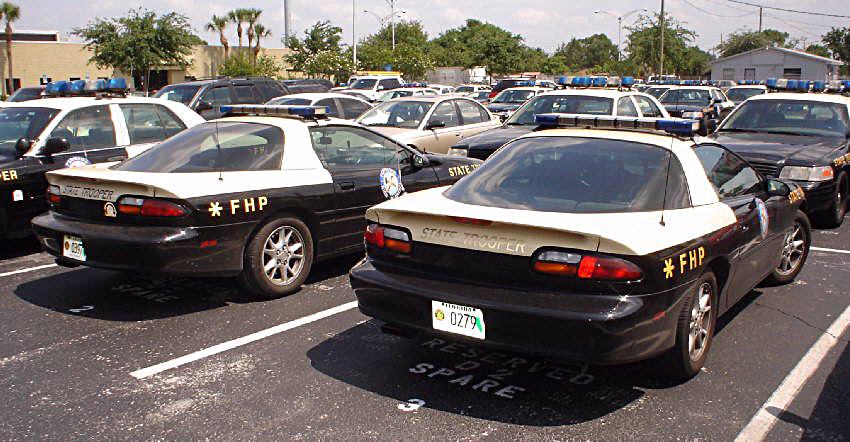
 2003-2014 issue. Second phase where the background changed to a cream colored field bordered in white.
2003-2014 issue. Second phase where the background changed to a cream colored field bordered in white. 
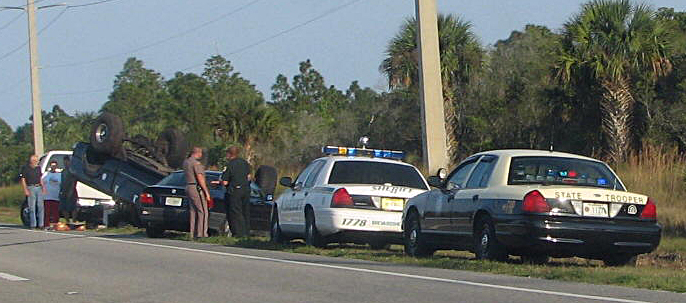
 2003-2014 issue. All-silkscreened version. Lighter shade of green for state silhouette.
2003-2014 issue. All-silkscreened version. Lighter shade of green for state silhouette.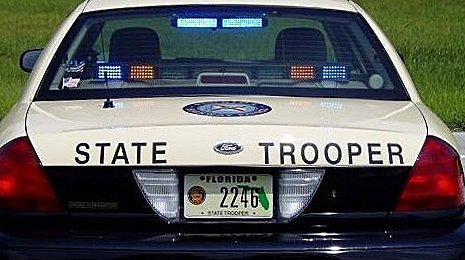
 2003-2014 issue.
2003-2014 issue. 

 2002 Prototype blank.
2002 Prototype blank. 2002 Prototype blank.
2002 Prototype blank.2014 marked the Florida Highway Patrol's 75th Anniversary. The occasion was marked with a variety of celebrations and keepsakes. One of which was an attractive Diamond Anniversary license plate for the marked FHP fleet. The embossed aluminum plate comprised of a black background trimmed in white along the step border. The state name was centered at the top of the plate in white trimmed orange silkscreen. STATE TROOPER was done the same way but placed at the bottom center of the plate. A stylized FHP shoulder patch emblem was silkscreened and occupied the far left field of the plate. The emblem had a curved white scroll banner with ANNIVERSARY spelled out in dark blue with miniature versions of FHP emblems. Below that on the lower portion of the orange, a diamond motif was flanked by 1939 and 2014 on either side. The assignment number was embossed in white mitered Florida DMV dies.
These plates were displayed on the rear of marked FHP vehicles for the duration of the anniversary.
In 2015, the FHP fleet returned to the 2003 layout license plate.
A souvenir version of this 75th Anniversary license plate was made with the characters FHP75 embossed in white in lieu of an assignment number (seen further below).
 2014 Diamond Anniversary issue. Embossed aluminum.
2014 Diamond Anniversary issue. Embossed aluminum.
In 2015, the popularity of the black background 75th Anniversary plate paved the way for continued use after the event by eliminating the diamond anniversary white band that spanned the center of the FHP emblem.
The "bannerless" black FHP license plates were still in use until 2024.
 2015-2024 issue.
2015-2024 issue. 


In 2024, the Florida Highway Patrol celebrated its 85th Anniversary. As part of the milestone celebration, the FHP designed and implemented an 85th Anniversary license plate for it marked fleet.
The plate was similar in design as the 75th Anniversarylicense plate using the white over black format with FLORIDA and STATE TROOPER in white-outlined orange.
A stylized FHP emblem with "85th Anniversary" was inscribed in the center of the emblem.
 2024 85th Anniversary issue. Embossed aluminum.
2024 85th Anniversary issue. Embossed aluminum.
From the beginning and up until 1953, FHP plates were issued in matched pairs to be run front and rear on the vehicles. From 1953 until at least 1970, no recognized or consistent front plates were used on FHP vehicles.
In 1970, a state safety campaign titled ARRIVE ALIVE went into full-swing that dealt with matters of proper highway speed, road manners and use of seat-belts where available. The FHP promoted this campaign to reduce motoring-related
deaths and injuries by affixing ARRIVE ALIVE license plates to the front of their patrol vehicles.
 1970-1971 ARRIVE ALIVE safety campaign front plate. Embossed steel. Reflective white over blue
1970-1971 ARRIVE ALIVE safety campaign front plate. Embossed steel. Reflective white over blue
 1972 ARRIVE ALIVE safety campaign front plate. Embossed steel.
1972 ARRIVE ALIVE safety campaign front plate. Embossed steel. 
 1973-circa 1980 ARRIVE ALIVE safety campaign front plate. Embossed steel. Undated multi-year type.
1973-circa 1980 ARRIVE ALIVE safety campaign front plate. Embossed steel. Undated multi-year type. 1977 Plymouth Fury with undated ARRIVE ALIVE plate
1977 Plymouth Fury with undated ARRIVE ALIVE plate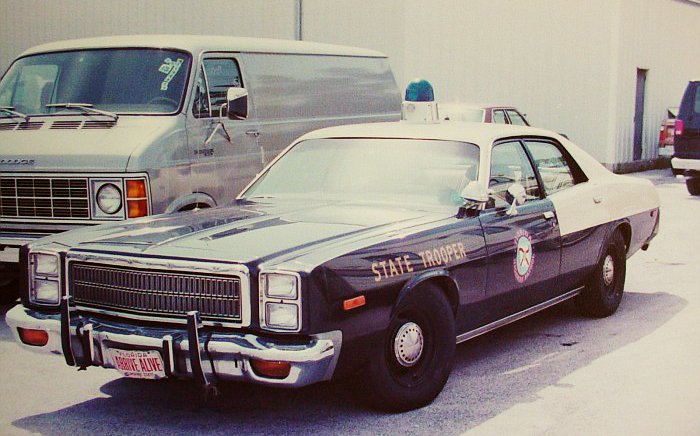
 Circa 1981-late 1980's ARRIVE ALIVE safety campaign front plate. Embossed aluminum. Similar to color/layout of standard passenger Florida license plates of the early 1980's with orange silhouette of state silkscreened at center of plate. Added the slogan BUCKLE UP along bottom.
Circa 1981-late 1980's ARRIVE ALIVE safety campaign front plate. Embossed aluminum. Similar to color/layout of standard passenger Florida license plates of the early 1980's with orange silhouette of state silkscreened at center of plate. Added the slogan BUCKLE UP along bottom.

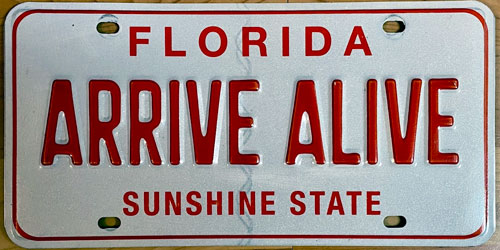 2017-Current style ARRIVE ALIVE
2017-Current style ARRIVE ALIVE
 Unknown “booster" type. 1981 base plate style. No state name- only silkscreened state silhouette in orange with word TROOPER embossed in green.
Unknown “booster" type. 1981 base plate style. No state name- only silkscreened state silhouette in orange with word TROOPER embossed in green.  Flat silkscreened metal “booster" type.
Flat silkscreened metal “booster" type. 
 Flat silkscreened plastic BUCKLE UP FLORIDA! “booster" type. Navy blue and RED over white. Unsure as to period of issue/use.
Flat silkscreened plastic BUCKLE UP FLORIDA! “booster" type. Navy blue and RED over white. Unsure as to period of issue/use. First “cellphone issue" front plate.
First “cellphone issue" front plate. 
 Flat silkscreened plastic/vinyl American Flag front plate. Issued from circa 1999 and used during replacement by aluminum replacements of the same layout in 2003.
Flat silkscreened plastic/vinyl American Flag front plate. Issued from circa 1999 and used during replacement by aluminum replacements of the same layout in 2003.
 2003-Current American flag front plate. This reflective aluminum plate was provided by 3M along with the new graphic rear plates introduced in 2003 and still currently in use.
2003-Current American flag front plate. This reflective aluminum plate was provided by 3M along with the new graphic rear plates introduced in 2003 and still currently in use.



 2014 issue. 75th Anniversary souvenir.
2014 issue. 75th Anniversary souvenir. Flat silkscreened metal FHP Auxiliary Trooper “booster" type. Navy blue, green and orange over white.
Flat silkscreened metal FHP Auxiliary Trooper “booster" type. Navy blue, green and orange over white. 75th Anniversary FHP State Trooper booster plate.
75th Anniversary FHP State Trooper booster plate. 75th Anniversary FHP Retiree booster plate.
75th Anniversary FHP Retiree booster plate.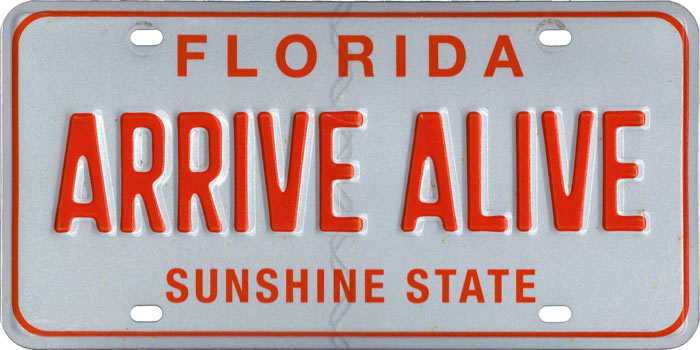 2017-current ARRIVE ALIVE safety campaign plate.
2017-current ARRIVE ALIVE safety campaign plate. 2019 ARRIVE ALIVE safety campaign plate.
2019 ARRIVE ALIVE safety campaign plate. 2002 prototype made with large metallic Major oak cluster emblem
2002 prototype made with large metallic Major oak cluster emblem
 Old Florida Highway Patrol Auxiliary “booster" plate. Painted steel with embossed border. These plates would be optional front plates for use by FHP Auxiliary (reserve) Troopers on their personal vehicles. Believed to have been specially-ordered in late 1960's/early 1970's.
Old Florida Highway Patrol Auxiliary “booster" plate. Painted steel with embossed border. These plates would be optional front plates for use by FHP Auxiliary (reserve) Troopers on their personal vehicles. Believed to have been specially-ordered in late 1960's/early 1970's. 
The earliest known surviving FHP motorcycle license plate dates back to 1942, but it may be safe to assume that FHP plates were issued to patrol motorcycles since the beginning and even perhaps during the State Road Department days. If the assumption is to be correct based on color schemes and formats in the state at that time and the fact that for most of the time, FHP plates were the painted in OPPOSITE colors of the standard used by civilian motorcycles at the time, this is how it should have played out. It is also an assumption that FHP issued motorcycle plates annually. All plates in horizontal format and embossed steel. The A prefix indicates large motorcycle over 5 HP
1939- White over red- 8" x 3" Clipped-cornered embossed
border- A 3 FLA 9 over FHP ##
1940- Black over white- 8" x 3" Clipped-cornered embossed
border- A 4 FLA 0 over FHP ##
1941- White over red- 8" x 3" Clipped-cornered embossed
border- A 4 FLA 1 over FHP ##
1942- Blue over orange- 8" x 3" Clipped-cornered
embossed border- A 4 FLA 2 over FHP ##
1943 tab on 42 base

 1942 motorcycle issue. Embossed steel. Approx. 8" x 3".
1942 motorcycle issue. Embossed steel. Approx. 8" x 3".
 1944 motorcycle issue. Embossed steel. Approx. 8"x3".
1944 motorcycle issue. Embossed steel. Approx. 8"x3". 

 1970's-1980's motorcycle issue. Silkscreened aluminum.
1970's-1980's motorcycle issue. Silkscreened aluminum. 
 Circa 1980's-1990's motorcycle issue. Embossed aluminum.
Circa 1980's-1990's motorcycle issue. Embossed aluminum.  Circa 1980's-1990's motorcycle issue. Embossed aluminum.
Circa 1980's-1990's motorcycle issue. Embossed aluminum. 
 2003-2015 morocycle issue.
2003-2015 morocycle issue.
 2016 motorcycle issue.
2016 motorcycle issue. 
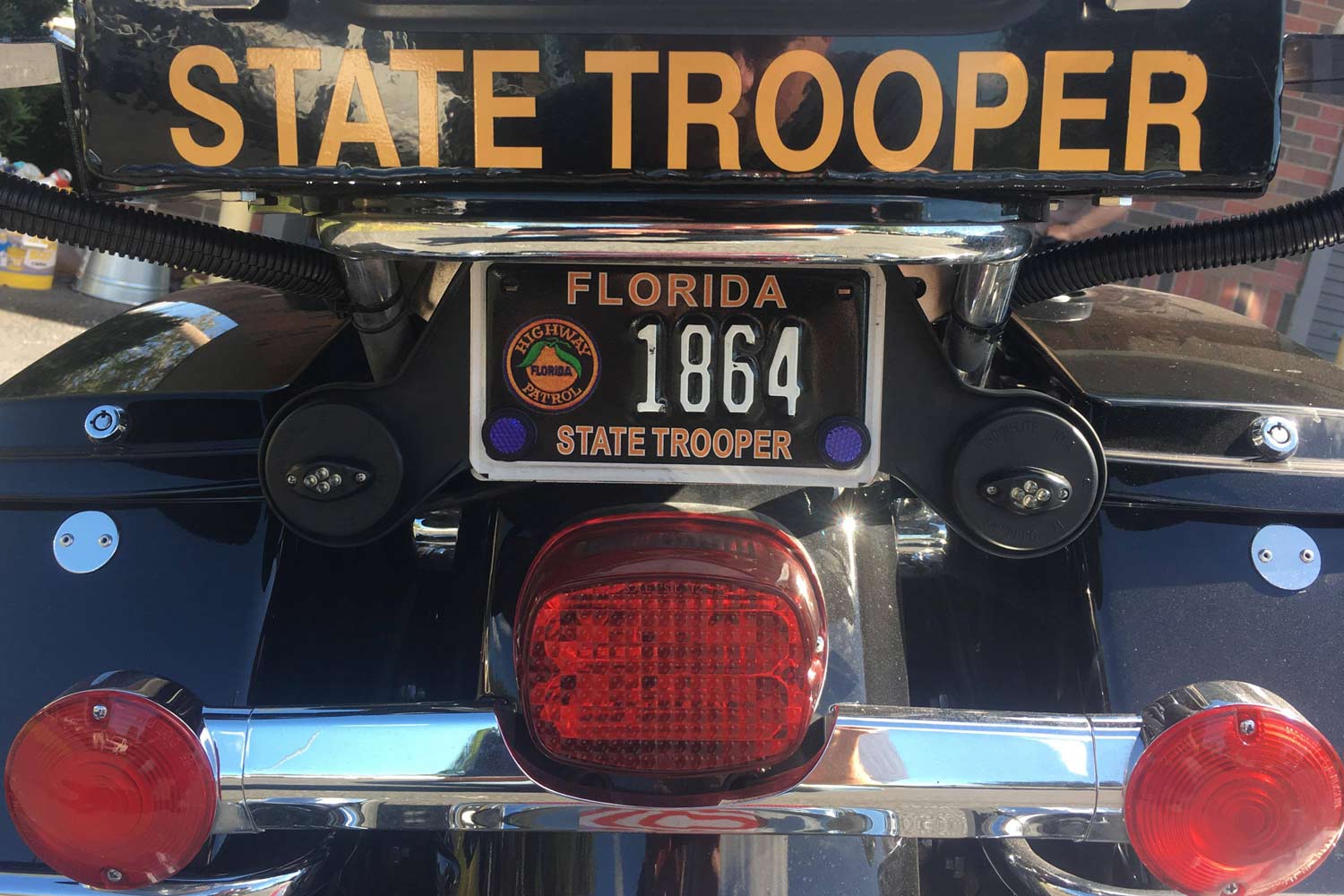 2015-Current style Florida Highway Patrol motorcycle plate.
2015-Current style Florida Highway Patrol motorcycle plate.Some souvenir or promotional license plates of the FHP have been made over the years. The majority of which have been National Trooper Coalition and International Association of Chiefs of Police conference souvenir plates. These plates are usually provided as gifts to visiting delegates from other police agencies who attend the hosted event.
As more are developed and discovered, I will showcase in this section.
 2005 International Chiefs of Police conference souvenir plate. This event took place in September of that year in Miami. Same compostion and material as regular contemporary FHP license plate including subdued helix hologram running down center of plate.
2005 International Chiefs of Police conference souvenir plate. This event took place in September of that year in Miami. Same compostion and material as regular contemporary FHP license plate including subdued helix hologram running down center of plate. 2005 National Troopers Coaliton conference souvenir plate. Same compostion and material as regular contemporary FHP license plate with exception of year 2005 in top left corner.
2005 National Troopers Coaliton conference souvenir plate. Same compostion and material as regular contemporary FHP license plate with exception of year 2005 in top left corner. 
As Florida is comprised primarily by coastline and waterways, enforcement of law on Florida's bodies of water were once overseen by the Florida Marine Patrol. These were the "Water Troopers" of the Sunshine State. The FMP, much like the FHP were comprised of sworn state law enforcement officers to ensure proactive and reactive policing under the oversight of the Florida Department of Natural Resources. FMP officers were armed and outfitted in uniforms and drove marked patrol cars similar to their brethren in the FHP with only color variances of same as well as a different style hat.
The Florida Marine Patrol, the Game and Fresh Water Fish Commission, the Florida Marine Research Institute and the Office of Fisheries Management and Assistance Services of the Florida Department of Environmental Protection all merged to form the Florida Fish and Wildlife Conservation Commission (FWC) on July 1, 1999 as required by an amendment to the Florida Constitution. The enforcement mandate of the DEP remains essentially the same, but the traditional FMP as it had come to be known is no more.
Only one type of license plate for FMP vehicles was known to be issued so far, and used for at least 30 years. A standard 6"x12" embossed steel plate in the dark blue over lemon yellow color scheme used on 1961 regular Florida license plates. The state name is embossed in upper case font and centered between the top mounting holes. The prefix FMP is followed by a parallelogram dash and a number up to three digits. The state slogan SUNSHINE STATE is centered between the lower mounting holes. It should be noted too that the FMP prefix uses dies that are slightly smaller than the number. It is believed that FMP license plates began at number 1 and went into the 900's. Different front plates or no front plates were used, however the most common type used was an embossed steel plate in dark blue over light yellow with FLORIDA emblazoned across the mid section of the plate.




 Florida Marine Patrol.
Florida Marine Patrol. 